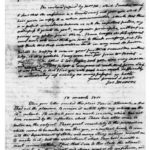This post is the third in the series, "Documenting a First Lady" The note recently located in the archive at William & Mary is extremely short, but in examining its few details, we are able to make connections to the larger picture of the Monroes' life in Washington, D.C. The note reads: Mrs Monroe requests Mr Smith will be so good as send by the bearer Tom, one hundred Dollars to the account of Mr Monroe Saturday January 21th 1815 This is not the first reference to Elizabeth Monroe managing her own finances. Bank records from the Monroes’ time in Washington show her withdrawing money for her own uses on other occasions as well. Given the glimpses of her independence and decisiveness shown in other surviving documents, it does not come as a surprise to see her accessing her own accounts in this way. The “Mr Smith” to whom the note is addressed is Richard Smith, cashier of the Bank of the United States in Washington. The first record of the family's account with … [Read more...]
Documenting a First Lady
This post is the second in the series "Documenting a First Lady" When discussing First Lady Elizabeth Monroe and the paucity of her written record, the immediate follow-on question is nearly always “How many of her letters have survived?” Quantifying the documentary record of any historic figure relies heavily on semantics – specifically, what counts as a letter? As a document? Which are being considered? In this case, Mrs. Monroe's written records fall primarily into two categories: correspondence in which she is either the author or recipient, and documents written in her hand but that are not necessarily intended to be communicative, such as mortgages or transaction records, or instances where she assisted her husband in copying out his letters. By limiting the parameters to items where she is either author or recipient, rather than amanuensis or signatory, staff at the Papers of James Monroe are currently aware of six letters. These include three documents that … [Read more...]
New First Lady Document Identified
This post is the first in the series "Documenting a First Lady" Conditioned as we are to the accessible and often voluminous correspondence of many early Americans, it frequently comes as a surprise to both the public and scholars to find out that there are fewer than a half-dozen surviving documents written by Elizabeth Kortright Monroe. According to their daughter, Eliza Hay, James Monroe burned his wife’s correspondence following her death in 1830. Such an act would not have been considered unusual by their contemporaries, as individuals of this era held a strongly defined sense of what constituted private, rather than public, correspondence. To historians, however, the five letters that currently constitute Elizabeth Monroe’s entire body of correspondence function as a tarnished mirror, allowing only fleeting and incomplete glimpses of this enigmatic First Lady. For decades, only one letter in her handwriting was known to have survived. Addressed … [Read more...]


